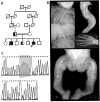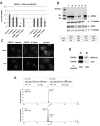Severe osteogenesis imperfecta caused by a small in-frame deletion in CRTAP
- PMID: 21964860
- PMCID: PMC3957185
- DOI: 10.1002/ajmg.a.34269
Severe osteogenesis imperfecta caused by a small in-frame deletion in CRTAP
Abstract
Mutations of proteins involved in posttranslational modification of collagen type I can cause osteogenesis imperfecta (OI) inherited in a recessive pattern. The cartilage-associated protein (CRTAP) is part of a heterotrimeric complex (together with prolyl-3-hydroxylase-1 [P3H1] and cyclophilin B) that 3-hydroxylates the alpha 1 chain of collagen type I at proline residue 986 and plays a collagen chaperon role. CRTAP mutations usually cause severe OI. We report on a patient with OI and a homozygous in-frame deletion in CRTAP and a severe form of OI. The girl was born with markedly deformed long bones. Despite intravenous bisphosphonate treatment, she developed multiple vertebral compression fractures and severe scoliosis and at 4 years of age was able to sit only with support. Although CRTAP transcript levels were normal in the patient's fibroblasts, protein levels of both CRTAP and P3H1 were severely reduced. The degree of 3-hydroxylation at proline residue 986 was also decreased. This report characterizes a patient with a CRTAP small in-frame deletion. We are unaware of prior reports of this finding. We suggest that this deletion affects crucial amino acids that are important for the interaction and/or stabilization of CRTAP and P3H1.
Copyright © 2011 Wiley Periodicals, Inc.
Figures


References
-
- Alanay Y, Avaygan H, Camacho N, Utine GE, Boduroglu K, Aktas D, Alikasifoglu M, Tuncbilek E, Orhan D, Bakar FT, Zabel B, Superti-Furga A, Bruckner-Tuderman L, Curry CJ, Pyott S, Byers PH, Eyre DR, Baldridge D, Lee B, Merrill AE, Davis EC, Cohn DH, Akarsu N, Krakow D. Mutations in the gene encoding the RER protein FKBP65 cause autosomal-recessive osteogenesis imperfecta. Am J Hum Genet. 2010;86:551–559. - PMC - PubMed
-
- Baldridge D, Schwarze U, Morello R, Lennington J, Bertin TK, Pace JM, Pepin MG, Weis M, Eyre DR, Walsh J, Lambert D, Green A, Robinson H, Michelson M, Houge G, Lindman C, Martin J, Ward J, Lemyre E, Mitchell JJ, Krakow D, Rimoin DL, Cohn DH, Byers PH, Lee B. CRTAP and LEPRE1 mutations in recessive osteogenesis imperfecta. Hum Mutat. 2008;29:1435–1442. - PMC - PubMed
-
- Barnes AM, Chang W, Morello R, Cabral WA, Weis M, Eyre DR, Leikin S, Makareeva E, Kuznetsova N, Uveges TE, Ashok A, Flor AW, Mulvihill JJ, Wilson PL, Sundaram UT, Lee B, Marini JC. Deficiency of cartilage-associated protein in recessive lethal osteogenesis imperfecta. N Engl J Med. 2006;355:2757–2764. - PMC - PubMed
Publication types
MeSH terms
Substances
Grants and funding
LinkOut - more resources
Full Text Sources
Medical

